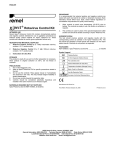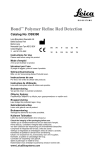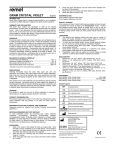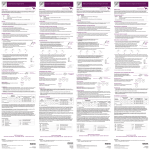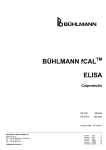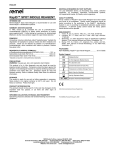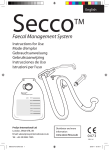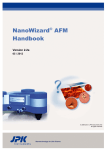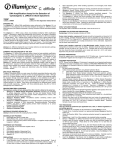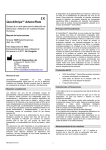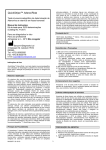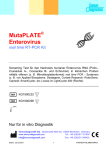Download Rotavirus
Transcript
ENGLISH • Rotavirus • • INTENDED USE ® Remel Xpect Rotavirus is a rapid, membrane-based, immunogold assay for the qualitative detection of rotavirus antigens in human fecal specimens intended for use as an aid in the diagnosis of acute gastroenteritis caused by rotavirus infections. This test is for professional use only. the onset of symptoms may not contain enough rotavirus antigen to produce a positive reaction. Do not collect specimens in containers having media, animal serum, detergents, or preservatives, as these substances may interfere with the assay. For infants and young children, a sample may be obtained from a soiled diaper, if necessary. Samples may be frozen if testing will be delayed. Quickly freeze the sample using dry ice, and keep frozen at -20°C or below until ready for testing. REAGENTS AND MATERIALS SUPPLIED 20 Tests 1. Test Devices (20): Membrane coated with monoclonal antirotavirus antibody that is affinity purified and specific to the capsid protein of rotavirus SUMMARY AND EXPLANATION Rotavirus is the major cause of life-threatening diarrhea (gastroenteritis) 1,2 in children younger than 2 years. Rotavirus gastroenteritis is ubiquitous and it occurs in all parts of the world. These doublestranded RNA viruses cause epidemic and endemic gastroenteritis in 3 geriatric as well as pediatric patients. It afflicts more than 130 million infants and children annually, causing 1 million deaths. The virus infects the epithelial cells lining the small intestine. After an incubation period of 1-2 days, the onset of acute gastroenteritis is sudden, with vomiting and diarrhea, fever, occasional abdominal 4 pain, and even respiratory symptoms. The duration of the disease and the symptoms may last between 5-8 days. ® 2. Tubes containing Xpect Rotavirus Extraction Buffer (20): Contains < 0.1% sodium azide 3. Disposable sample transfer pipettes (20) 4. Instructions for Use (IFU) MATERIALS REQUIRED BUT NOT SUPPLIED ® 1. Xpect Rotavirus Control Kit (REF R246551) or characterized positive and negative specimens to use as controls The gold standard for detecting human rotavirus depends on electron 5 microscopy since existing tissue culture methods are unreliable. ® Xpect Rotavirus offers a fast, simple method for the detection of rotavirus and rotavirus antigens. 2. Stool specimen collection container(s) 3. Timer 4. Vortex 5. Centrifuge PROCEDURE Note: Specimens must be extracted using the provided tubes which ® contain Xpect Rotavirus Extraction Buffer. PRINCIPLE ® Xpect Rotavirus utilizes a pair of rotavirus-specific antibodies in an immunochromatographic sandwich assay. An extract is first prepared by suspension of the specimen in the provided extraction buffer solution. The buffer containing the extracted specimen is then added to the device sample well. The reaction between a positive sample and the colored particle-conjugated antibody will form a complex that migrates along the membrane. An immobilized capture antibody will form a colored line at the S (specimen) area upon reacting with the colored complex. An internal control line C (control) area is built-in to ensure that the test has been performed correctly. STORAGE ® Store Xpect Rotavirus kit at room temperature until the expiration date printed on the box. The test device must remain in the sealed pouch until ready for use. 1. Allow the kit components and specimens to equilibrate to room temperature prior to testing. 2. Mix stool specimen thoroughly prior to testing (regardless of the consistency). 3. Using a swab, add sufficient stool specimen (30-50 mg) to an ® Xpect Rotavirus Extraction Buffer tube. 4. Rub swab meticulously against the inner wall of tube in order to release the fecal material. 5. For best results, vortex the tube for 60 seconds. Allow the sediment to settle for 2-5 minutes before performing the test. Note: To produce a supernatant that will allow proper migration along the test device membrane, centrifuge thick or mucoid stools after extraction at a speed capable of producing a pellet (12,000 g). PRECAUTIONS 1. For In Vitro Diagnostic Use 2. Standard precautions should be taken against the dangers of biological hazards by properly sterilizing specimens, containers, and test devices after use. Consult appropriate references when 6 necessary. 3. Directions should be read and followed carefully. 4. Kit components and reagents are provided at the necessary working strength; do not dilute. 5. Do not interchange reagents between kits of different lots. 6. Do not use reagents beyond the printed expiration dates. 7. Microbial contamination of reagents may decrease the accuracy of the assay and cause false results. 8. Do not reuse kit components or test devices. 6. Remove the test device from the foil pouch when ready to perform the test and place it on a flat surface. 7. Using the provided transfer pipettes, dispense 4 drops of the supernatant into the round sample well of the device (see illustration below). Wait for colored lines to appear. Dropper SPECIMEN COLLECTION, STORAGE, AND TRANSPORT • Specimens should be collected in clean, dry, plastic or glass containers. • Collect specimens during the acute phase of gastroenteritis at which time viral particles and antigens are excreted in large numbers. Peak viral counts usually occur 3-5 days after the onset of symptoms. Samples collected more than 7 days after Test Device 8. 1 Read results at 15 minutes. Some positive results may be observed very quickly (i.e., 30 seconds) depending on the concentration of antigen. Do not interpret results after 30 minutes. ENGLISH 5. INTERPRETATION Negative Results: The test is negative if only one colored line appears in the C (control) area. Coinfection with bacterial pathogens is possible. Testing for presence of bacterial pathogens should be performed in parallel ® with Xpect Rotavirus. EXPECTED VALUES Rotavirus infection is seasonal and is the most frequent cause of gastroenteritis in children between 6 months and 3 years of age. Among young children hospitalized for gastroenteritis, it is expected 7 that up to 50% of patient specimens will test positive for rotavirus. The prevalence of rotavirus infection will vary based on many factors such as age, geographic location, method of sample collection, sample handling and transportation, and the general health environment of the patient population under study. Normal healthy individuals tested should be negative for rotavirus. Some infected individuals may show no symptoms or only minor symptoms, and these patients may test negative. Negative Positive Results: The test is positive if two colored lines appear. One colored line will appear in the S (specimen) area and one in the C (control) area. Any colored line in the S area should be considered positive. Colored lines may be lighter or darker than each other. PERFORMANCE CHARACTERISTICS ® Xpect Rotavirus was evaluated in laboratories and hospitals in the United States and Japan for the direct testing of patient stool samples. A total of 185 samples were tested, and the results compared to the ® Meridian Premier™ Rotaclone EIA test and to electron microscopy (EM). Positive Sites I & II U.S. Site III Japan EM Meridian Rotaclone + – 13 2 0 70 Comparison Invalid Results: The test is invalid if no colored line appears in the C (control) area, even if a colored line appears in the S (specimen) area. If this occurs, add 1 to 2 additional drops of sample and wait for 5 minutes. If a colored line does not appear in the C area, the test is invalid and should be repeated. If the line in the C area still does not appear, contact Remel Technical Service at 800-447-3641. Colored lines, which appear after 30 minutes are not diagnostic and should be ignored. ® Xpect Rotavirus QUALITY CONTROL Internal: Each test device includes a built-in procedural control, containing anti-mouse antibody that captures the colored conjugate antibody. Correct procedural technique and test device performance is confirmed when a colored line appears in the C (control) area of the device. The procedural control line does not test for the presence or absence of rotavirus and should appear whether the sample tested is positive or negative. + – + 50 0 Performance Statistics Value Sensitivity 100% Specificity 100% Agreement 100% – 0 50 95% C.I. 92.9%100% 92.9%100% 96.4%100% Value Relative Sensitivity Relative Specificity Relative Agreement 100% 97.2% 97.7% ® 95% C.I. 75.3%100% 90.3%99.7% 91.8%99.7% Note: Relative refers to comparison of assay results with that of a similar assay. No attempt was made to correlate assay results with disease presence or absence. No judgment can be made on the accuracy of the comparison assay to predict disease. External: Controls should be tested with each new kit lot number or following established laboratory procedures. The controls provided in ® Xpect Rotavirus Control Kit (REF R246551) should be tested following the procedure in the IFU included in the control kit. Characterized positive and negative specimens can be used as ® controls in place of Xpect Rotavirus Control Kit. Each laboratory should follow their quality control procedures established according to federal, state, or local guidelines. REPRODUCIBILITY ® Three different lots of Xpect Rotavirus were tested in multiple replicates using negative, low-positive, and high-positive samples. Reproducibility was tested within each lot, between lots, between different test sites, and on different days. In each case, all tests yielded 100% reproducibility. LIMITS OF DETECTION A study was performed in Tokyo, Japan to determine the limits of ® detection of Xpect Rotavirus. A human rotavirus antigen (HRV) was taken from culture and purified by ultra-centrifugation with 30% sucrose. The initial concentration of HRV was measured through spectrophotometry, and serial dilutions were prepared and tested ® using Xpect Rotavirus. Through this process, it was determined that the lower limit of detection of the test is a concentration of 24.3 ng/ml (ng of virus particles). LIMITATIONS ® 1. The monoclonal antibody in Xpect Rotavirus is highly sensitive and specific for rotavirus antigen; however, it cannot be used to differentiate types of rotavirus. 2. A negative result does not exclude the possibility of rotavirus infection in the patient. False-negative results may occur with specimens containing rotavirus antigen concentrations below the test detection level. 3. Test performance is highly dependent on proper specimen collection and preparation. Care should be taken to follow the procedure as directed in the kit IFU. 4. Samples collected more than 7 days after the onset of symptoms may not contain enough rotavirus antigens to produce a positive reaction. CROSS REACTIVITY Common intestinal pathogens and other organisms occasionally ® present in feces were tested with Xpect Rotavirus in order to verify that they did not interfere with the test and that no cross-reactivity would occur. The following organisms were tested at a concentration of 1.0 10 x 10 organisms/ml and showed no cross-reactivity: 2 ENGLISH Microorganisms Brucella abortus Citobacter freundii Enterococcus faecalis Escherichia coli Klebsiella pneumoniae Proteus vulgaris Pseudomonas aeruginosa Salmonella Enteriditis Salmonella Paratyphi Salmonella Typhi Salmonella Typhimurium Shigella dysenteriae Vibrio cholerae Viruses Astrovirus Calicivirus Enteric adenovirus PACKAGING ® REF R24655, Xpect Rotavirus ......................................... 20 Tests/Kit Symbol Legend REF Catalog Number IVD In Vitro Diagnostic Medical Device LAB For Laboratory Use Consult Instructions for Use (IFU) Temperature Limitation (Storage Temp.) LOT BIBLIOGRAPHY 1. 2. 3. 4. 5. 6. 7. Murray, P.R., E.J. Baron, J.H. Jorgensen, M.L. Landry, and M.A. Pfaller. 2007. Manual of Clinical Microbiology. 9th ed. ASM Press, Washington, D.C. Cimons, M. 1998. ASM News. 64:6-7. Kaplan, J.E., G.W. Gary, R.C. Baron, N. Singh, L.B. Schonberger, R. Feldman, and H.B. Greenberg. 1982. Ann. Intern. Med. 96:756-761. Christensen, M.L. 1989. Clin. Microbiol. Rev. 2:51-89. Mathewson, J.J., D.K. Winsor, Jr., H.L. DuPont, and S.L. Secor. 1989. Diagn. Microbiol. Infect. Dis. 12:139-141. Richmond, J.Y. and R.W. McKinney. 1999. Biosafety in Microbiological and Biomedical Laboratories. 4th ed. U.S. Dept. of H.H.S., CDC and National Institutes of Health, Washington, D.C. Cukor, G., D.M. Perron, R. Hudson, and N.R. Blacklow. 1984. J. Clin. Microbiol. 19:888-892. Batch Code (Lot Number) Use By (Expiration Date) EC REP European Authorized Representative Manufactured for Remel Inc. Premier™ is a trademark of Meridian Bioscience, Inc. Rotaclone® is a registered trademark of Meridian Bioscience, Inc. IFU 24655, Revised April 28, 2008 12076 Santa Fe Drive, Lenexa, KS 66215, USA General Information: (800) 255-6730 Technical Service: (800) 447-3641 Order Entry: (800) 447-3635 Local/International Phone: (913) 888-0939 International Fax: (913) 895-4128 Website: www.remel.com Email: [email protected] Printed in U.S.A. GERMAN PROBENENTNAHME, LAGERUNG UND TRANSPORT • Die Proben sollten in sauberen, luftdicht verschlossenen und auslaufsicheren Plastik- oder Glasbehältern gesammelt werden. • Die Proben sollten während der akuten Phase der Gastroenterritis entnommen werden, wenn die viralen Partikel und Antigene in großer Zahl ausgeschieden werden. Die maximale Virenanzahl tritt in der Regel 3-5 Tage nach dem Einsetzen der Symptome auf. Proben, die später als 7 Tage nach Einsetzen der Symptome entnommen werden, enthalten möglicherweise nicht genug Rotavirus-Antigen, um eine positive Reaktion hervorzurufen. • Die Proben nicht in Behälter mit Lösungsmitteln, Tierserum, Reinigungs- oder Konservierungsmitteln geben, da diese Substanzen den Test beeinträchtigen können. • Bei Säuglingen und Kleinkindern kann, falls erforderlich, eine Probe aus einer benutzten Windel entnommen werden. • Die Proben können eingefroren werden, sofern sich die Durchführung des Tests verzögert. Die Proben in diesem Fall unverzüglich mit Trockeneis einfrieren und bis zur Durchführung des Tests bei – 20 °C oder tieferen Temperaturen lagern. Rotavirus INDIKATIONEN ® Remel Xpect Rotavirus ist ein membranbasierender ImmunogoldSchnelltest für den qualitativen Nachweis von Rotavirus-Antigenen in menschlichen Stuhlproben. Er unterstützt die Diagnose von akuter Gastroenteritis aufgrund von Rotavirus-Infektionen. Dieser Test eignet sich nur für die Anwendung durch Fachpersonal. ZUSAMMENFASSENDE ERKLÄRUNG Rotavirus ist die häufigste Ursache für lebensbedrohliche Diarrhöe 1,2 Die Rotavirus(Gastroenteritis) bei Kindern unter 2 Jahren. Gastroenteritis kommt in allen Teilen der Welt vor. Diese doppelsträngigen RNA-Viren verursachen epidemische und 3 endemische Gastroenteritis bei älteren und Kindern Menschen. An ihnen erkranken jährlich mehr als 130 Millionen Säuglinge und Kinder und sie verursachen eine Million Todesfälle. IM LIEFERUMFANG ENTHALTENE REAGENZIEN UND MATERIALIEN 1. Testgeräte (20): Mit monoklonalen Anti-Rotavirus-Antikörpern beschichtete Membran (affinitätschromatographisch gereinigt und spezifisch zum Hüllprotein des Rotavirus) ® 2. Röhrchen mit Xpect Rotavirus-Extraktionspuffer (20): Enthält < 0,1 % Natriumazid 3. Einwegpipetten (20) 4. Gebrauchsanweisung (IFU) Das Virus befällt die Epithelzellen entlang des kleinen Intestinums. Die akute Gastroenteritis beginnt nach einer Inkubationsphase von 1 - 2 Tagen plötzlich mit Erbrechen und Diarrhöe, Fieber, gelegentlichem Abdominalschmerz und vereinzelt auch mit respiratorischen 4 Symptomen. Die Erkrankung und die Symptome können zwischen 5 - 8 Tagen andauern. Die allseits bewährte Methode für den Nachweis des Rotavirus beim Menschen ist die Elektronenmikroskopie, da die bestehenden 5 ® Gewebekulturmethoden unzuverlässig sind. Xpect Rotavirus stellt eine schnelle und einfache Methode zum Nachweis des Rotavirus und der Rotavirus-Antigene dar. BENÖTIGTE MATERIALIEN (NICHT IM LIEFERUMFANG ENTHALTEN) ® 1. Xpect Rotavirus Control Kit (REF R246551) oder bereits spezifizierte positive oder negative Proben als Kontrolle 2. Stuhlproben-Sammelbehälter 3. Labortimer 4. Vortexen 5. Zentrifuge TESTPRINZIP ® Rotavirus verwendet ein Paar Rotavirus-spezifischer Xpect Antikörper in einem immunochromatographischen Sandwich-Test. Zuerst wird durch Lösung der Probe in der beiliegenden Extraktionspufferlösung ein Extrakt vorbereitet. Der Puffer mit der extrahierten Probe wird dann in den Probenschacht des Gerätes gegeben. Die Reaktion zwischen einer positiven Probe und dem gefärbten Partikel-konjugierten Antikörper bildet einen Komplex, der entlang der Membran migriert. Ein immobilisierter “Capture Antibody“ bildet bei der Reaktion mit dem Farbkomplex im S-Bereich (Probe) eine farbige Linie. Um sicherzustellen, dass der Test ordnungsgemäß ausgeführt wurde, ist eine interne C-Kontrolllinie (C = Control) integriert. VERFAHREN Hinweis: Die Proben müssen unter Verwendung des mitgelieferten ® Rotavirus-Extraktionspuffer Probenröhrchens mit dem Xpect extrahiert werden. 1. 2. 3. 4. LAGERUNG Das Produkt sollte bis zum Ablauf des auf der Packung aufgedruckten Verfallsdatums bei Raumtemperatur gelagert werden. Das Testgerät muss bis zu seiner Verwendung im versiegelten Beutel belassen werden. 5. Die Kit-Komponenten und die Proben sich vor dem Test auf Zimmertemperatur erwärmen lassen. Stuhlproben unabhängig von der Konsistenz vor dem Test sorgfältig mischen. Mit einem Stäbchen ausreichend Stuhlprobe (30–50 mg) in das Röhrchen mit dem Xpect® Rotavirus-Extraktionspuffer geben. Das Stäbchen an der Innenseite des Röhrchens sorgfältig abstreifen, damit die Stuhlprobe in das Röhrchen übergeht. Um optimale Ergebnisse zu erzielen, das Röhrchen 60 Sekunden lang verwirbeln. Vor der Durchführung des Tests das Sediment sich 2-5 Minuten lang absetzen lassen. Hinweis: Um einen Überstand herzustellen, der eine korrekte Migration entlang der Membran des Testgeräts ermöglicht, muss man dicke oder mukoide Stühle nach der Extraktion bei einer Geschwindigkeit (12 000 g) zentrifugieren, die einen festen Niederschlag erzeugen kann. VORSICHTSMASSNAHMEN 1. Nur zur Verwendung in der In-Vitro-Diagnostik. 2. Als Vorsichtsmaßnahme gegen die von biologischen Materialien ausgehenden Gefahren müssen Proben, Behälter und Testgeräte nach Gebrauch ordnungsgemäß sterilisiert werden. Weitere Informationen sind bei Bedarf der entsprechenden 6 Dokumentation zu entnehmen. 3. Die gegebenen Anweisungen sollten aufmerksam gelesen und genau befolgt werden. 4. Kit-Komponenten und Reagenzien werden in der erforderlichen Konzentration geliefert; nicht verdünnen. 5. Die Reagenzien von Kits verschiedener Chargen dürfen nicht ausgetauscht werden. 6. Die Reagenzien nicht nach dem aufgedruckten Verfallsdatum verwenden. 7. Eine mikrobielle Kontaminierung von Reagenzien kann die Testgenauigkeit vermindern und falsche Ergebnisse hervorbringen. 8. Bestandteile des Kits bzw. der Testgeräte sind nur zum einmaligen Gebrauch bestimmt. 6. 7. Das Testgerät vor dem Test aus dem Plastikbeutel nehmen und auf eine flache Oberfläche legen. 4 Tropfen des Überstands mit den mitgelieferten Transferpipetten in den runden Probenschacht des Testgerätes überführen (siehe untere Abbildung). Auf das Erscheinen der farbigen Linien warten. Dropper Testgerät 4 GERMAN 8. Testergebnisse nach 15 Minuten ablesen. Abhängig von der Antigen-Konzentration können einige positive Ergebnisse bereits nach sehr kurzer Zeit (d.h. in weniger als 30 Sekunden) beobachtet werden. Nach 30 Minuten Ergebnisse nicht mehr interpretieren. 3. 4. INTERPRETATION Negative Ergebnisse: Der Test ist negativ, wenn nur eine farbige Linie im C-Bereich (Kontrolle) erscheint. 5. Das Testergebnis hängt stark von der korrekten Entnahme und Aufbereitung der Proben ab. Man sollte sich streng an die Vorgaben in der Gebrauchsanweisung des Kits zur Durchführung des Verfahrens halten. Proben, die später als 7 Tage nach Einsetzen der Symptome entnommen werden, enthalten möglicherweise nicht genug Rotavirus-Antigene, um eine positive Reaktion hervorzurufen. Die Koinfektion mit bakteriellen Pathogenen ist möglich. Es ® sollte parallel zum Xpect Rotavirus auf das Vorhandensein von bakteriellen Pathogenen getestet werden. ZU ERWARTENDE WERTE Die Rotavirus-Infektion ist jahreszeitlich bedingt und ist bei Kindern im Alter zwischen 6 Monaten und 3 Jahren die häufigste Ursache für Gastroenteritis. Es wird angenommen, dass bis zu 50 % der Proben von Kleinkindern, die wegen Gastroenteritis ins Krankenhaus 7 eingewiesen werden, positiv auf Rotavirus getestet werden. Die Prävalenz der Rotavirus-Infektion schwankt aufgrund vieler Faktoren, wie Alter, geografischem Standort, Probenahmemethode, Handhabung und Transport der Probe sowie der allgemeinen Gesundheitsbedingungen der untersuchten Patientenpopulation. Normal gesunde Personen, die getestet werden, müssen gegen Rotavirus negativ sein. Einige infizierte Personen können Symptome oder nur minimale Symptome aufweisen. Diese Patienten können im Test negativ ausfallen. Negativ Positive Ergebnisse: Der Test ist positiv, wenn zwei farbige Linien erscheinen. Eine farbige Linie erscheint im S-Bereich (Probe) und eine im C-Bereich (Kontrolle). Jegliche Färbung im S-Bereich muss als positiv bewertet werden. Farbige Linien können heller oder dunkler als andere ausfallen. LEISTUNGSMERKMALE ® Xpect Rotavirus wurde von Laboren und Krankenhäusern in den Vereinigten Staaten und Japan für das Testen frischer Stuhlproben von Patienten bewertet. Insgesamt wurden 185 Proben getestet. Die ® Ergebnisse wurden mit dem Meridian Premier™ Rotaclone EIA-Test und mit der Elektronenmikroskopie (EM) verglichen. Positiv Ungültige Ergebnisse: Der Test ist ungültig, wenn im C-Bereich (Kontrolle) keine farbige Linie erscheint, selbst wenn der S-Bereich (Probe) ein farbige Linie aufweist. In diesem Fall 1 bis 2 weitere Tropfen der Probe hinzufügen und 5 Minuten warten. Wenn im C-Bereich keine farbige Linie erscheint, ist der Test ungültig und sollte wiederholt werden. Sollte im C-Bereich wiederholt keine farbige Linie erscheinen, kontaktieren Sie den Kundendienst von Remel unter 800-447-3641 (nur innerh. der USA). Farbige Linien, die nach 30 Minuten erscheinen, sind nicht diagnoserelevant und sollten ignoriert werden. Standorte I & II USA Standort III Japan EM Meridian Rotaclone® + – 13 2 Vergleich Xpect® Rotavirus + + 50 – 0 – 0 50 Leistungsstatistik QUALITÄTSKONTROLLE Intern: Jedes Testgerät enthält eine integrierte Verfahrenskontrolle mit einen Anti-Maus-Antikörper, der das gefärbte Antikörperkonjugat bindet. Wenn im C-Bereich (Kontrolle) eine farbige Linie erscheint, bestätigt dies die methodisch korrekte Durchführung des Tests und die korrekte Funktion des Testgeräts. Die Verfahrenskontrolllinie testet nicht die An- oder Abwesenheit des Rotavirus und sollte unabhängig von einem positiven oder negativen Testergebnis der Probe erscheinen. Wert Sensitivität 100% Spezifität 100% Übereinstimmung 100% VB 95% 0 70 Wert VB 95% 92,9% Relative 75,3%100% -100% Sensitivität 100% 92,9% Relative 90,3%97,2% -100% Spezifität 99,7% 96,4% Relative 91,8%97,7% -100% Übereinstimmung 99,7% Hinweis: Bitte beachten Sie, dass sich “relativ” auf den Vergleich mit Testergebnissen aus einem ähnlichen Test bezieht. Die Testergebnisse wurden nicht mit der An- oder Abwesenheit der Erkrankung in Beziehung gesetzt. Die Genauigkeit des Vergleichstests zur Vorhersage der Erkrankung kann nicht beurteilt werden. Extern: Die Kontrollen sollten bei jeder neuen Kit-Chargennummer oder entsprechend den im Labor üblichen Verfahren geprüft werden. ® Rotavirus Control Kit Die Kontrollen, die mit dem Xpect (REF R246551) geliefert werden, sollten entsprechend dem in der Gebrauchsan-weisung des Kontroll-Kits beschriebenen Verfahren geprüft werden. Bereits spezifizierte positive und negative Proben ® können statt des Xpect Rotavirus Control Kit als Kontrolle verwendet werden. Jedes Labor sollte seinen im Einklang mit den Richtlinien des Bundes, des Landes oder der Kommune festgelegten Verfahren zur Qualitätskontrolle folgen. WIEDERHOLBARKEIT ® Es wurden drei verschiedene Chargen Xpect Rotavirus in mehreren Wiederholungen mit negativen, schwach positiven und stark positiven Proben getestet. Die Reproduzierbarkeit wurde innerhalb jeder Charge, zwischen den Chargen, zwischen verschiedenen Standorten und an verschiedenen Tagen getestet. In jedem einzelnen Fall wurde eine Reproduzierbarkeit von 100 % erreicht. NACHWEISGRENZEN ® Zur Feststellung der Nachweisgrenzen des Xpect Rotavirus wurde eine Studie in Tokio, Japan, durchgeführt. In der Studie wurde ein durch Ultra-Zentrifugation mit 30 % Sukrose isoliertes menschliches Rotavirus-Antigen (Human Rotavirus Antigen, HRV) aus Kultur verwendet. Die Anfangskonzentration des HRV wurde spektrophoto® metrisch ermittelt, serielle Verdünnungen erstellt und mit Xpect Rotavirus getestet. Dabei wurde festgestellt, dass die untere Nachweisgrenze für den Test bei einer Konzentration von 24,3 ng/ml (ng Viruspartikel) erreicht ist. EINSCHRÄNKUNGEN ® Rotavirus ist 1. Der monoklonale Antikörper in Xpect hochempfindlich und spezifisch für das Rotavirus-Antigen; trotzdem kann es nicht zur Differenzierung verschiedener Typen von Rotaviren verwendet werden. 2. Ein negatives Ergebnis schließt die Möglichkeit einer RotavirusInfektion des Patienten jedoch nicht aus. Falsch-negative Ergebnisse können bei Proben auftreten, die Konzentrationen des Rotavirus-Antigens unterhalb des messbaren Testbereichs aufweisen. 5 GERMAN KREUZREAKTIVITÄT Zum Nachweis, dass gewöhnliche intestinale Pathogene und andere Organismen, die im Stuhl gelegentlich vorkommen, den Test nicht beeinträchtigen und dass keine Kreuzreaktivität auftritt, wurden sie ® 10 mit Xpect Rotavirus getestet. Bei einer Konzentration von 1,0 x 10 Organismen/ml wurden folgende Organismen getestet. Es konnte keine Kreuzreaktivität nachgewiesen werden. Mikroorganismen Brucella abortus Citrobacter freundii Enterococcus faecalis Escherichia coli Klebsiella pneumoniae Proteus vulgaris Pseudomonas aeruginosa Salmonella Enteriditis Salmonella Paratyphi Salmonella Typhi Salmonella Typhimurium Shigella dysenteriae Vibrio cholerae Viren Astrovirus Calicivirus Enteraler Adenovirus 6. 7. Richmond, J.Y. and R.W. McKinney. 1999. Biosafety in Microbiological and Biomedical Laboratories. 4th ed. U.S. Dept. of H.H.S., CDC and National Institutes of Health, Washington, D.C. Cukor, G., D.M. Perron, R. Hudson, and N.R. Blacklow. 1984. J. Clin. Microbiol. 19:888-892. PACKUNGSINHALT ® REF R24655, Xpect Rotavirus ......................................... 20 Tests/Kit Symbollegende REF Katalognummer IVD Medizinprodukt für die In-vitro-Diagnostik LAB Für den Laborbedarf Gebrauchsanweisung beachten (IFU) Temperaturbereich (Lagerungstemperatur) LOT Chargenbezeichnung (Chargennummer) Verwendbar bis (Verfallsdatum) EC REP Autorisierte Vertretung für EU-Länder LITERATURVERWEISE 1. 2. 3. 4. 5. Murray, P.R., E.J. Baron, J.H. Jorgensen, M.L. Landry, and M.A. Pfaller. 2007. Manual of Clinical Microbiology. 9th ed. ASM Press, Washington, D.C. Cimons, M. 1998. ASM News. 64:6-7. Kaplan, J.E., G.W. Gary, R.C. Baron, N. Singh, L.B. Schonberger, R. Feldman, and H.B. Greenberg. 1982. Ann. Intern. Med. 96:756-761. Christensen, M.L. 1989. Clin. Microbiol. Rev. 2:51-89. Mathewson, J.J., D.K. Winsor, Jr., H.L. DuPont, and S.L. Secor. 1989. Diagn. Microbiol. Infect. Dis. 12:139-141. Hergestellt für Remel Inc. Premier™ ist eine Marke der Meridian Bioscience, Inc. Rotaclone® ist eine Marke der Meridian Bioscience, Inc. IFU 24655. Revidierte Fassung vom 2008-04-28 Printed in U.S.A. 12076 Santa Fe Drive, Lenexa, KS 66215, USA Allgemeine Informationen: (800) 255-6730 Technische Unterstützung: (800) 447-3641 (nur innerh. USA) Bestellungen: (800) 447-3635 Local/International Phone: (913) 888-0939 International Fax: (913) 895-4128 Website: www.remel.com E-Mail: [email protected] FRENCH RECUEIL, CONSERVATION ET TRANSPORT DES PRÉLÈVEMENTS • Les échantillons doivent être placés dans des récipients propres et secs, de plastique ou de verre. • Prélever les échantillons durant la phase aiguë de gastroentérite où les particules et antigènes viraux sont excrétés en grand nombre. Les charges virales atteignent généralement un pic entre 3 et 5 jours après l'apparition des symptômes. Les échantillons prélevés plus de 7 jours après l’apparition des symptômes peuvent ne pas contenir suffisamment d’antigènes du rotavirus pour produire une réaction positive. • Ne pas prélever d’échantillons dans des récipients contenant des milieux, du sérum animal, des détergents ou des conservateurs car ces substances pourraient interférer avec le test. • Pour les bébés et les jeunes enfants, il est possible de recueillir l'échantillon dans une couche souillée si nécessaire. • Les échantillons peuvent être congelés si le test doit être retardé. Congeler rapidement les échantillons à l’aide de glace sèche et les conserver au congélateur à -20°C ou moins, jusqu’à ce qu’ils soient prêts à être testés. Rotavirus UTILISATION PRÉVUE ® Xpect Rotavirus de Remel est un test immunogold rapide basé sur membrane destiné à la détection qualitative d’antigènes du rotavirus dans des échantillons fécaux humains pour faciliter le diagnostic de la gastro-entérite aiguë due à une infection par rotavirus. Ce test est exclusivement réservé à une utilisation professionnelle. RÉSUMÉ ET EXPLICATION Le rotavirus est la principale cause de diarrhée mortelle (gastro1,2 entérite) chez les enfants de moins de 2 ans. La gastro-entérite à rotavirus est très répandue et touche toutes les régions du monde. Ces virus à ARN à double brin provoquent des gastro-entérites épidémiques et endémiques chez les patients gériatriques et 3 pédiatriques. Chaque année, cette maladie touche plus de 130 millions de nourrissons et d’enfants, causant ainsi 1 million de décès. Le virus infecte les cellules épithéliales longeant l’intestin grêle. Après une période d’incubation de 1 à 2 jours, l’apparition d’une gastroentérite aiguë est subite, avec vomissements et diarrhée, fièvre, douleurs abdominales occasionnelles, voire même symptômes 4 respiratoires. La maladie et les symptômes peuvent durer de 5 à 8 jours. L’étalon-or permettant de détecter le rotavirus humain dépend de la microscopie électronique dans la mesure où les méthodes de culture 5 ® des tissus existantes sont peu fiables. Xpect Rotavirus propose une méthode simple et rapide de détection du rotavirus et des antigènes du rotavirus. RÉACTIFS ET MATÉRIEL FOURNIS 1. Dispositifs de test (20): Membrane revêtue d’anticorps monoclonal anti-rotavirus purifié par affinité et spécifique à la protéine de capside du rotavirus ® 2. Tubes contenant un tampon d’extraction Xpect Rotavirus (20): Contient < 0,1 % d’azide de sodium 3. Pipettes de transfert d’échantillons jetables (20) 4. Mode d'emploi (IFU) MATÉRIEL REQUIS MAIS NON FOURNI ® 1. Le kit de contrôle Xpect Rotavirus (RÉF R246551) ou des échantillons positifs ou négatifs caractérisés à utiliser comme témoins de contrôle 2. Pot(s) pour prélèvement des échantillons de selles 3. Minuteur 4. Vortexer 5. Centrifugeuse PRINCIPE ® Xpect Rotavirus utilise une paire d’anticorps spécifiques du rotavirus dans le cadre d’un dosage immunochromatographique en sandwich. Un extrait est tout d’abord préparé par suspension de l’échantillon dans la solution tampon d’extraction fournie. Le tampon contenant l’extrait d’échantillon est ensuite placé dans le puits d’échantillons du dispositif. La réaction entre un échantillon positif et l’anticorps conjugué à des particules colorées forme un complexe qui migre le long de la membrane. Un anticorps de capture immobilisé forme une ligne colorée dans la zone S (échantillon) lorsqu’il réagit avec le complexe coloré. La zone C (contrôle) de la ligne de contrôle interne est intégrée pour garantir que le test a été correctement exécuté. PROCÉDURE Remarque : Les échantillons doivent être extraits à l'aide des tubes ® fournis qui contiennent le tampon d'extraction Xpect Rotavirus. CONSERVATION Le produit doit être conservé à température ambiante jusqu’à la date de péremption imprimée sur la boîte. Le dispositif de test doit rester dans le sachet hermétiquement fermé jusqu’à ce qu’il soit prêt à l’emploi. PRÉCAUTIONS 1. Pour utilisation diagnostique in vitro uniquement. 2. Toutes les précautions standard contre les risques biologiques doivent être prises en stérilisant correctement les échantillons, les récipients et les dispositifs de test après usage. Consulter la 6 documentation appropriée lorsque cela est nécessaire. 3. Toutes les instructions doivent être lues attentivement et scrupuleusement respectées. 4. Les composants et réactifs du kit sont fournis testés prêts à l'emploi ; ne pas diluer. 5. Les réactifs provenant de kits de différents lots ne sont pas interchangeables. 6. Ne pas utiliser les réactifs après les dates de péremption imprimées. 7. La contamination microbienne des réactifs peut diminuer la précision du test et fausser les résultats. 8. Ne pas réutiliser les composants du kit ni les dispositifs de test. 1. Laisser les composants du kit et les échantillons revenir à température ambiante avant de procéder au test. 2. Bien mélanger l'échantillon fécal avant le test (quelle que soit la consistance). 3. À l’aide d’un écouvillon, placer suffisamment d’échantillon de selles (30-50 mg) dans un tube contenant le tampon d’extraction ® Xpect Rotavirus. 4. Frotter méticuleusement l’écouvillon contre la paroi intérieure du tube afin de libérer la matière fécale. 5. Pour un meilleur résultat, agiter au mélangeur vortex durant 60 secondes. Laisser les particules solides se déposer durant 2 à 5 minutes avant de procéder au test. Remarque: Pour produire un surnageant qui permette la migration appropriée le long de la membrane du dispositif de test, centrifuger les selles épaisses ou mucoïdes après extraction, à une vitesse capable de produire un culot (12 000 g). 7 6. Lorsque tout est prêt pour le test, sortir le dispositif de test de la poche métallisée et le placer sur une surface plane. 7. À l’aide des pipettes de transfert fournies, déposer 4 gouttes de surnageant dans le puits d’échantillon circulaire du dispositif (voir l’illustration ci-dessous). Attendre que les lignes colorées apparaissent. FRENCH LIMITES ® 1. L'anticorps monoclonal du Xpect Rotavirus est extrêmement sensible et spécifique à l'antigène du rotavirus ; il ne peut toutefois pas être utilisé pour différencier les types de rotavirus. 2. Un résultat négatif n’exclut pas la possibilité d’une infection par rotavirus chez le patient. De faux résultats négatifs peuvent survenir avec les échantillons contenant des concentrations d'antigène de rotavirus inférieures au seuil de détection du test. 3. La performance du test dépend avant tout d'un prélèvement et d'une préparation d'échantillon appropriés. Il faut veiller à suivre la procédure telle qu'elle est indiquée dans le mode d'emploi du kit. 4. Les échantillons prélevés plus de 7 jours après l’apparition des symptômes peuvent ne pas contenir suffisamment d’antigènes du rotavirus pour produire une réaction positive. 5. Une co-infection par des agents pathogènes bactériens est possible. Un test de détection de présence d'agents pathogènes ® bactériens doit être réalisé parallèlement au test Xpect Rotavirus. Comptegouttes Dispositif de test 8. Lire les résultats à 15 minutes. En fonction de la concentration d’antigène, certains résultats positifs peuvent être observés très rapidement (dans les 30 secondes). Au-delà de 30 minutes, ne pas interpréter les résultats. INTERPRÉTATION Résultats négatifs: Le test est négatif si une seule ligne colorée apparaît dans la zone C (contrôle). VALEURS ATTENDUES L’infection par rotavirus est saisonnière. Elle constitue la cause la plus fréquence de gastro-entérite chez les enfants âgés de 6 mois à 3 ans. Parmi les jeunes enfants hospitalisés pour cause de gastroentérite, on prévoit que le pourcentage d’échantillons de patients 7 testés positifs au rotavirus atteigne 50%. La prévalence de l’infection par rotavirus varie en fonction de nombreux facteurs comme l’âge, la situation géographique, les modalités de prélèvement, de manipulation et de transport des échantillons, ainsi que l’environnement sanitaire général de la population de patients étudiée. Les individus en bonne santé doivent être testés négatifs au rotavirus. Certains individus infectés peuvent présenter des symptômes ou des symptômes mineurs uniquement et être testés négatifs. Négatif Résultats positifs : Le test est positif si deux lignes colorées apparaissent. Une ligne colorée apparaît dans la zone S (échantillon) et une autre dans la zone C (contrôle). Toute ligne colorée de la zone S doit être considérée comme un résultat positif. L’intensité de la couleur des lignes peut varier. CARACTÉRISTIQUES DE PERFORMANCE ® Xpect Rotavirus a été évalué dans des laboratoires et des hôpitaux des États-Unis et du Japon concernant le test direct d'échantillons de selles de patients. Au total, 185 échantillons ont été testés et les ® résultats ont été comparés au test Rotaclone EIA de Meridian TM Premier et à la microscopie électronique (ME). Comparaison Positif Xpect® Rotavirus Résultats non valides : Le test n’est pas valide si aucune ligne colorée n’apparaît dans la zone C (contrôle), même s’il y en a une dans la zone S (échantillon). Dans ce cas, déposer 1 à 2 gouttes supplémentaires d’échantillon et attendre 5 minutes. Si aucune ligne colorée n’apparaît dans la zone C, le test n’est pas valide et doit être répété. Si la ligne de la zone C n’apparaît toujours pas, contacter le service technique de Remel au 800-447-3641. Les lignes colorées qui apparaissent au-delà de 30 minutes sont sans intérêt diagnostique et doivent être ignorées. Sites I et II, USA ME + – Site III, Japon Rotaclone® de Meridian + – + 50 0 13 2 – 0 50 0 70 Statistiques de Valeur IC de 95% Valeur IC de 95% performance 92,9%Sensibilité 75,3%100 % 100% Sensibilité 100 % relative 100% 92,9%Spécificité 90,3%100 % 97,2% Spécificité 100% relative 99,7% 96,4%- Concordance 91,8%97,7% Concordance 100 % 100% relative 99,7% CONTRÔLE QUALITÉ Interne : Chaque dispositif de test comprend un contrôle procédural intégré contenant un anticorps anti-souris qui capture l’anticorps conjugué coloré. La qualité de la technique procédurale et de la performance du dispositif de test est confirmée par l’apparition d’une ligne colorée dans la zone C (contrôle) du dispositif. La ligne de contrôle procédural ne teste pas la présence ou l'absence du rotavirus et doit apparaître que l'échantillon testé soit positif ou négatif. Remarque: il convient de remarquer que « relative » se rapporte à la comparaison entre les résultats du test et ceux d'un test similaire. Il n’a aucunement été tenté d’établir une corrélation entre les résultats du test et la présence ou l’absence de maladie. Aucun jugement ne peut être porté sur l’exactitude du test de comparaison pour prévoir la maladie. Externe : Les contrôles doivent être testés avec chaque nouveau numéro de lot de kit ou selon les procédures de laboratoire établies. ® Les contrôles fournis dans le kit de contrôle Xpect Rotavirus (RÉF R246551) doivent être testés selon la procédure indiquée dans le mode d'emploi contenu dans le kit de contrôle. Les échantillons positifs et négatifs caractérisés peuvent être utilisés comme contrôles ® à la place du kit de contrôle Xpect Rotavirus. Chaque laboratoire doit suivre ses procédures de contrôle de qualité, établies conformément aux directives fédérales, d'État ou locales. REPRODUCTIBILITÉ ® Trois lots différents de Xpect Rotavirus ont été testés plusieurs fois à l’aide d’échantillons négatifs, faiblement positifs et hautement positifs. On a effectué des tests de reproductibilité dans chaque lot, entre les lots, entre différents sites de test et à des jours différents. Dans chaque cas, tous les tests ont présenté une reproductibilité de 100 %. 8 FRENCH LIMITES DE DÉTECTION Une étude a été menée à Tokyo, au Japon, afin de déterminer les ® limites de détection de Xpect Rotavirus. L’étude impliquait l’utilisation d’un antigène du rotavirus humain (RVH) prélevé en culture et purifié par ultra-centrifugation avec 30% de sucrose. La concentration initiale de RVH a été mesurée par spectrophotométrie et des dilutions en série ont été préparées, puis testées à l’aide de ® Xpect Rotavirus. Ce processus a permis de déterminer que la limite inférieure de détection du test correspond à une concentration de 24,3 ng/ml (ng de particules du virus). RÉACTIVITÉ CROISÉE Les agents pathogènes intestinaux courants et d’autres organismes ® parfois présents dans les matières fécales ont été testés avec Xpect Rotavirus afin de vérifier qu’ils n’interféraient pas avec le test et qu’aucune réactivité croisée ne se produisait. Les organismes suivants ont été testés à une concentration de 1,0 x 1010 organismes/ml. Ils n’ont présenté aucune réactivité croisée. Micro-organismes Brucella abortus Citobacter freundii Enterococcus faecalis Escherichia coli Klebsiella pneumoniae Proteus vulgaris Pseudomonas aeruginosa Salmonella Enteriditis Salmonella Paratyphi Salmonella Typhi Salmonella Typhimurium Shigella dysenteriae Vibrio cholerae Virus Astrovirus Calicivirus Adénovirus entérique BIBLIOGRAPHIE 1. 2. 3. 4. 5. 6. 7. Murray, P.R., E.J. Baron, J.H. Jorgensen, M.L. Landry, and M.A. Pfaller. 2007. Manual of Clinical Microbiology. 9th ed. ASM Press, Washington, D.C. Cimons, M. 1998. ASM News. 64:6-7. Kaplan, J.E., G.W. Gary, R.C. Baron, N. Singh, L.B. Schonberger, R. Feldman, and H.B. Greenberg. 1982. Ann. Intern. Med. 96:756-761. Christensen, M.L. 1989. Clin. Microbiol. Rev. 2:51-89. Mathewson, J.J., D.K. Winsor, Jr., H.L. DuPont, and S.L. Secor. 1989. Diagn. Microbiol. Infect. Dis. 12:139-141. Richmond, J.Y. and R.W. McKinney. 1999. Biosafety in Microbiological and Biomedical Laboratories. 4th ed. U.S. Dept. of H.H.S., CDC and National Institutes of Health, Washington, D.C. Cukor, G., D.M. Perron, R. Hudson, and N.R. Blacklow. 1984. J. Clin. Microbiol. 19:888-892. CONDITIONNEMENT ® REF R24655, Xpect Rotavirus ........................................... 20 tests/kit Légende des Symboles REF Numéro de référence IVD Dispositif médical de diagnostic in vitro LAB Pour utilisation en laboratoire Lire le mode d'emploi (IFU) Limites de température (conservation) LOT Code de lot (numéro de lot) À utiliser avant le (date de péremption) EC REP Représentant autorisé pour l'UE Fabriqué pour Remel Inc. Premier™ est une marque déposée de Meridian Bioscience, Inc. Rotaclone® est une marque commerciale de Meridian Bioscience, Inc. IFU 24655, révisé le 2008-04-28 Imprimé aux États-Unis d’Amérique 12076 Santa Fe Drive, Lenexa, KS 66215, États-Unis Renseignements : (800) 255-6730 Service technique : (800) 447-3641 Service commercial : (800) 447-3635 Téléphone national/international : +1 913 888-0939 Télécopie (international) : +1 (913) 895-4128 Site Web : www.remel.com E-mail : [email protected] ITALIAN Rotavirus • USO PREVISTO ® Il test Remel Xpect Rotavirus è un saggio rapido, su membrana che utilizza anticorpi marcati con oro per l'identificazione qualitativa degli antigeni di rotavirus in campioni fecali umani come aiuto nella diagnosi della gastroenterite acuta causata da infezioni di rotavirus. Questo test è indicato esclusivamente per uso professionale. • • DESCRIZIONE DEL PRODOTTO Il rotavirus è la principale causa di gastroenteriti (diarrea) 1,2 potenzialmente fatali in bambini con età inferiore a 2 anni. La gastroenterite da rotavirus è ubiquitaria e diffusa in tutto il mondo. Questo virus a RNA a doppio filamento causa gastroenteriti 3 epidemiche ed endemiche nella popolazione geriatrica e pediatrica. Colpisce più di 130 milioni di neonati e bambini ogni anno, causando 1 milione di decessi. quantità. Il picco della conta virale si verifica generalmente 3-5 giorni dopo l'insorgenza dei sintomi. I campioni prelevati dopo più di 7 giorni dall'insorgenza dei sintomi possono non contenere un numero di antigeni di rotavirus sufficiente a produrre la reazione positiva. Non prelevare i campioni in contenitori con terreni, siero di animali, detergenti o conservanti, poiché queste sostanze possono interagire con il test. Se necessario, per i neonati e per i bambini, è possibile ottenere il campione dal pannolino utilizzato. I campioni possono essere congelati, qualora si esegua il test successivamente. Congelare rapidamente il campione usando ghiaccio secco e mantenerlo congelato a -20°C o a temperature inferiori fino al momento del test. REAGENTI E MATERIALI FORNITI 1. Dispositivi per test (20): membrana rivestita con anticorpi monoclonali anti-rotavirus, purificati per affinità e specifici per la proteina del capside di rotavirus ® 2. Provette contenenti il tampone di estrazione Xpect Rotavirus (20): contiene sodio azide < 0,1% 3. Pipette di trasferimento monouso per campione (20) 4. Istruzioni per l'uso (IFU) Il virus infetta le cellule del rivestimento epiteliale dell'intestino tenue. Dopo un periodo di incubazione di 1-2 giorni, la gastroenterite insorge rapidamente con vomito, diarrea, febbre e a volte dolore addominale 4 e anche sintomi respiratori. I sintomi dell'infezione possono durare 58 giorni. MATERIALE NECESSARIO MA NON FORNITO ® 1. Kit di controllo Xpect Rotavirus (REF R246551) o campioni negativi e positivi caratterizzati, da utilizzare come controlli 2. Contenitori per la raccolta dei campioni fecali 3. Timer 4. Vortex 5. Centrifuga Il gold standard per l'identificazione del rotavirus umano è l'analisi al microscopio elettronico, poiché i metodi disponibili di cultura tissutale 5 ® non sono attendibili. Il test Xpect Rotavirus offre un metodo rapido e semplice per l'identificazione di rotavirus e di antigeni di rotavirus. PROCEDURA Nota: I campioni devono essere estratti utilizzando le provette fornite ® contenenti il tampone di estrazione Xpect Rotavirus. PRINCIPIO ® Il test Xpect Rotavirus usa una coppia di anticorpi specifici per il rotavirus in un saggio immunocromatografico a sandwich. Dalla sospensione del campione si prepara un estratto nel tampone di estrazione fornito. Il tampone contenente il campione estratto viene quindi aggiunto al pozzetto del campione del dispositivo. La reazione tra un campione positivo e l’anticorpo coniugato con una particella colorata forma un complesso che migra lungo la membrana. Se l'anticorpo di cattura immobilizzato si lega al complesso colorato, nell'area S (campione) si forma una linea colorata. È presente un'area C (controllo) con linea di controllo interno per garantire che il test sia stato eseguito correttamente. CONDIZIONI DI CONSERVAZIONE Il prodotto deve essere conservato a temperatura ambiente fino alla data di scadenza stampata sulla confezione. Il dispositivo per test deve essere tenuto nella busta sigillata fino al momento dell'uso. 1. Lasciare stabilizzare i campioni e i componenti del kit a temperatura ambiente prima di eseguire il test. 2. Miscelare accuratamente i campioni fecali prima del test (indipendentemente dalla consistenza). 3. Con un tampone, aggiungere una quantità sufficiente di campione fecale (30-50 mg) ad una provetta con tampone di ® estrazione Xpect Rotavirus. 4. Schiacciare accuratamente il tampone contro la parte interna della provetta al fine di rilasciare il materiale fecale. 5. Per ottenere dei risultati ottimali, miscelare la provetta su vortex per 60 secondi. Lasciar depositare il sedimento per 2-5 minuti, prima di eseguire il test. Nota: Per produrre un sovranatante in grado di consentire un'appropriata migrazione lungo la membrana del dispositivo per test, centrifugare le feci dense o mucoidi dopo l'estrazione, ad una velocità sufficiente per la produzione di pellet (12.000 g). PRECAUZIONI 1. Esclusivamente per uso diagnostico In Vitro. 2. Si raccomanda di attenersi alle normali precauzioni contro eventuali rischi biologici, sterilizzando opportunamente campioni, contenitori e dispositivi per test dopo l'uso. Consultare 6 la bibliografia appropriata se necessario. 3. Leggere con attenzione le istruzioni contenute in questo documento e attenervisi scrupolosamente. 4. I reagenti e i componenti del kit vengono forniti già diluiti in modo ottimale; non diluire. 5. Non scambiare alcun reagente di un kit con altri di un lotto differente. 6. Non utilizzare reagenti scaduti. 7. La contaminazione batterica dei reagenti può ridurre la precisione del saggio inficiando i risultati. 8. Non riutilizzare componenti del kit o dispositivi per test. 6. Quando si è pronti ad eseguire il test, estrarre il dispositivo per test dalla confezione e posizionarlo su una superficie piatta. 7. Utilizzando le pipette di trasferimento fornite, dispensare 4 gocce di sovranatante nel pozzetto per campione circolare del dispositivo (vedere l'illustrazione seguente). Attendere la comparsa delle linee colorate. Contagocce PRELIEVO, CONSERVAZIONE E TRASPORTO DEI CAMPIONI • I campioni devono essere prelevati utilizzando contenitori di vetro o di plastica, puliti e asciutti. • Prelevare i campioni durante la fase acuta della gastroenterite, quando le particelle e gli antigeni virali sono escreti in grande Dispositivo per test 10 ITALIAN 8. Leggere i risultati del saggio entro 15 minuti. Alcuni risultati positivi possono essere osservati molto rapidamente (ad es. 30 secondi) a seconda della concentrazione di antigene. Non eseguire l'interpretazione dei risultati dopo 30 minuti. 3. 4. INTERPRETAZIONE Risultati negative: Il test è negativo, se appare una sola linea colorata nell'area C (controllo). 5. La prestazione del test dipende specificamente dalla corretta preparazione e dal corretto prelievo del campione. Prestare attenzione nel seguire le procedure come indicato nelle istruzioni per l'uso del kit. I campioni prelevati dopo più di 7 giorni dall'insorgenza dei sintomi possono non contenere un numero di antigeni di rotavirus sufficiente a produrre la reazione positiva. È possibile la coinfezione con patogeni batterici. Parallelamente ® al Xpect Rotavirus, eseguire i test per verificare la presenza di batteri patogeni. RISULTATI ATTESI L'infezione da rotavirus è stagionale ed è la causa più frequente di gastroenterite nei bambini da 6 mesi a 3 anni di età. Si prevede che il 50% dei campioni di pazienti pediatrici ospedalizzati per gastroenterite 7 sia positivo per rotavirus. La prevalenza del rotavirus varia in base a molti fattori, quali età, area geografica, metodo di prelievo del campione, manipolazione e trasporto del campione e situazione sanitaria della popolazione dei pazienti in studio. Gli individui sani testati devono essere negativi per rotavirus. Alcuni individui infettati che mostrano i sintomi o solo sintomi minori possono risultare negativi. Negativo Risultati positivi: Il test è positivo, se appaiono due linee colorate. Una linea colorata appare nell'area S (campione) e una nell'area C (controllo). Qualsiasi linea colorata nell'area S deve essere considerata positiva. Le linee colorate possono essere una più chiara o più scura dell'altra. CARATTARISTICHE DI ESCUZIONE ® Il test Xpect Rotavirus è stato valutato in laboratori e ospedali negli Stati Uniti e in Giappone per il test diretto su campioni fecali. Sono stati testati un totale di 185 campioni e i risultati sono stati confrontati ® con il test Meridian Premier™ Rotaclone EIA e la microscopia elettronica (EM). Positivo Strutture I & II U.S. EM + – Confronto Risultati non validi: Il test non è valido se nell'area C (controllo) non appare alcuna linea colorata, anche se appare una linea colorata nell'area S (campione). In questo caso aggiungere 1 o 2 gocce di campione e attendere 5 minuti. Se nell'area C (controllo) non appare alcuna linea colorata, il risultato del test non è valido. Se la linea nell'area C non appare ancora, contattare il Remel Technical Service al numero telefonico 800-447-3641. Le linee colorate che appaiono dopo 30 minuti non sono diagnostiche e devono essere ignorate. + 50 0 13 2 – 0 50 0 70 Dati statistici Valore della prestazione 95% C.I. Test Xpect® Rotavirus CONTROLLO QUALITÀ Interno: Ogni dispositivo per test contiene un controllo procedurale interno, costituito da un anticorpo monoclonale anti-topo che cattura l'anticorpo coniugato colorato. La corretta tecnica procedurale e la corretta prestazione del dispositivo per test vengono confermati dall’apparizione di una linea colorata nell'area C (controllo) del dispositivo. La linea di controllo procedurale non dimostra la presenza o l'assenza del rotavirus e dovrebbe comparire sia se il campione testato è positivo che negativo. Struttura III in Giappone Test Meridian Rotaclone® + – Sensibilità 100% Specificità 100% Concordanza 100% 92,9%100% 92,9%100% 96,4%100% Valore Sensibilità relativa Specificità relativa Concordanza relativa 100% 97,2% 97,7% 95% C.I. 75,3%100% 90,3%99,7% 91,8%99,7% Nota: Il termine "relativa" si riferisce al confronto dei risultati del test a un test similare. Non è stato compiuto alcun tentativo di correlare i risultati del test alla presenza o assenza della malattia. Non è stato formulato alcun giudizio sull'accuratezza del test di confronto relativamente alla predizione della malattia. Esterno: Testare i controlli con ogni nuovo numero di lotto di kit o seguendo le procedure definite dal laboratorio. I controlli forniti nel kit ® di controllo Xpect Rotavirus (REF R246551) devono essere testati seguendo la procedura riportata nelle istruzioni per l'uso contenute ® nel kit di controllo. In luogo del kit di controllo Xpect Rotavirus è possibile utilizzare come controlli i campioni caratterizzati come positivi e negativi. Ogni laboratorio deve seguire la proprie procedure di controllo qualità, in accordo alle normative locali, statali o federali. RIPRODUCIBILITÀ ® Sono stati testati tre lotti differenti del test Xpect Rotavirus in più replicati usando campioni negativi scarsamente o altamente positivi. È stata testata la riproducibilità all'interno di ogni lotto, tra lotti, tra strutture diverse e tra giorni diversi. In tutti casi tutti i test mostravano il 100% di riproducibilità. LIMITI DI RILEVAMENTO ® Il limite di rilevamento del test Xpect Rotavirus è stato determinato a Tokyo, in Giappone. Lo studio coinvolto usava un antigene umano di rotavirus (ARV) prelevato da cultura e purificato per ultracentrifugazione con 30% di saccarosio. La concentrazione iniziale dell'HRV è stata misurata mediante spettrofotometria, quindi sono state preparate ® diluizioni seriali che sono state testate con il test Xpect Rotavirus. In questo modo si è determinato che il limite inferiore di rilevamento del test è pari a 24,3 ng/ml (ng di particelle virali). LIMITAZIONI ® 1. L'anticorpo monoclonale contenuto in Xpect Rotavirus è altamente sensibile e specifico per l'antigene di rotavirus; tuttavia, non può essere utilizzato per differenziare i diversi tipi di rotavirus. 2. Un risultato negativo non esclude la possibilità di un'infezione da rotavirus del paziente. Si possono verificare risultati falsinegativi, qualora la concentrazione di antigene di rotavirus contenuta nei campioni sia inferiore al livello di rilevamento del test. 11 ITALIAN REATTIVITÀ CROCIATA Per verificare l'interferenza con il test e l'assenza di reattività crociata, ® sono stati testati con il test Xpect Rotavirus i comuni patogeni intestinali e altri organismi presenti occasionalmente nelle feci. I seguenti organismi sono stati testati a una concentrazione pari a 1,0 10 x 10 organismi/ml e non hanno mostrato reattività crociata. Microrganismi Brucella abortus Citobacter freundii Enterococcus faecalis Escherichia coli Klebsiella pneumoniae Proteus vulgaris Pseudomonas aeruginosa Salmonella Enteriditis Salmonella Paratyphi Salmonella Typhi Salmonella Typhimurium Shigella dysenteriae Vibrio cholerae Virus Astrovirus Calicivirus Adenovirus enterico 6. 7. Richmond, J.Y. and R.W. McKinney. 1999. Biosafety in Microbiological and Biomedical Laboratories. 4th ed. U.S. Dept. of H.H.S., CDC and National Institutes of Health, Washington, D.C. Cukor, G., D.M. Perron, R. Hudson, and N.R. Blacklow. 1984. J. Clin. Microbiol. 19:888-892. CONFEZIONE ® REF R24655, Xpect Rotavirus ............................................. 20 test/kit Spiegazioni dei Simboli REF Codice numero IVD Dispositivo per uso diagnostico in vitro LAB Per uso in laboratorio Consultare le istruzioni per l'uso (IFU) Limitazioni per temperatura (Temp. di conservazione) LOT Codice lotto (Numero Lotto) Da utilizzare entro (data di scadenza) EC REP Rappresentante autorizzato per l'Europa BIBLIOGRAFIA 1. 2. 3. 4. 5. Murray, P.R., E.J. Baron, J.H. Jorgensen, M.L. Landry, and M.A. Pfaller. 2007. Manual of Clinical Microbiology. 9th ed. ASM Press, Washington, D.C. Cimons, M. 1998. ASM News. 64:6-7. Kaplan, J.E., G.W. Gary, R.C. Baron, N. Singh, L.B. Schonberger, R. Feldman, and H.B. Greenberg. 1982. Ann. Intern. Med. 96:756-761. Christensen, M.L. 1989. Clin. Microbiol. Rev. 2:51-89. Mathewson, J.J., D.K. Winsor, Jr., H.L. DuPont, and S.L. Secor. 1989. Diagn. Microbiol. Infect. Dis. 12:139-141. Prodotto per Remel Inc. Premier™ è un marchio di fabbrica di Meridian Bioscience, Inc. Rotaclone® è un marchio di fabbrica di Meridian Bioscience, inc. IFU 24655, data revisione:2008-04-28 12076 Santa Fe Drive, Lenexa, KS 66215, USA Informazioni generali (800) 255-6730 Technical Service: (800) 447-3641 Order Entry: (800) 447-3635 Tel. locale/internazionale (913) 888-0939 International Fax: (913) 895-4128 Sito Web: www.remel.com Indirizzo posta elettronica: [email protected] Stampato in U.S.A. SPANISH Rotavirus • USO PREVISTO ® Remel Xpect Rotavirus es un análisis rápido, de tipo inmuno-oro, con membrana, para la detección cualitativa de antígenos de rotavirus en muestras de materia fecal humana, con el fin de facilitar el diagnóstico de la gastroenteritis aguda causada por infecciones por rotavirus. Este análisis es para uso profesional únicamente. • • RESUMEN Y EXPLICACIÓN Los rotavirus son la principal causa de diarrea potencialmente mortal 1,2 La gastroenteritis (gastroenteritis) en niños menores de dos años. por rotavirus es ubicua; se da en todo el mundo. Estos virus ARN de doble cadena causan gastroenteritis epidémica y endémica en 3 pacientes geriátricos y pediátricos. Cada año afectan a más de 130 millones de lactantes y niños, y causan un millón de muertes. excretan en grandes cantidades. Los valores máximos de los recuentos de virus suelen producirse de tres a cinco días después de la aparición de los síntomas. Las muestras recogidas más de siete días después de la aparición de los síntomas pueden no contener suficientes antígenos de rotavirus para producir una reacción positiva. No recoja las muestras en recipientes que contengan medios, suero animal, detergentes o conservantes, ya que estas sustancias pueden interferir con el análisis. En el caso de bebés y niños pequeños, puede obtenerse una muestra de un pañal sucio, si es necesario. Las muestras pueden congelarse en el caso de demorarse las pruebas. Congele rápidamente las muestras con hielo seco y manténgalas congeladas a una temperatura de –20 °C o inferior, hasta el momento de realizar la prueba. REACTIVOS Y MATERIALES SUMINISTRADOS 1. Dispositivos de análisis (20): Membrana recubierta con anticuerpo anti-rotavirus monoclonal, purificado por afinidad y específico de la proteína de la cápside del rotavirus ® 2. Tubos con solución tampón de extracción Xpect Rotavirus (20): Contiene azida sódica al < 0,1 % 3. Pipetas de transferencia de muestras desechables (20) 4. Instrucciones de uso (IFU) El virus infecta las células epiteliales que recubren el intestino delgado. Tras un período de incubación de uno a dos días, la aparición de la gastroenteritis aguda es súbita y está acompañada de vómitos y diarrea, fiebre, dolor abdominal ocasional e incluso 4 síntomas respiratorios. La enfermedad y los síntomas pueden durar de cinco a ocho días. MATERIALES NECESARIOS PERO NO SUMINISTRADOS ® 1. Xpect Rotavirus Control Kit (REF R246551) o muestras positivas y negativas caracterizadas para utilizar como controles 2. Recipiente(s) para recoger las muestras fecales 3. Cronómetro 4. Vórtex 5. Centrífuga El método preferido para la detección de los rotavirus humanos es la microscopia electrónica, ya que los métodos basados en el cultivo de 5 ® tejidos no son fiables. Xpect Rotavirus ofrece un método rápido y sencillo para la detección de rotavirus y antígenos de rotavirus. PRINCIPIO DE LA PRUEBA ® Xpect Rotavirus utiliza un par de anticuerpos específicos contra rotavirus, en un análisis inmunocromatográfico de tipo sándwich. Primero, se prepara un extracto mediante la suspensión de la muestra en la solución tampón de extracción suministrada. A continuación, se añade la solución tampón que contiene la muestra extraída al pocillo de muestra del dispositivo. La reacción entre una muestra positiva y el anticuerpo conjugado con partículas de color forma un complejo que migra a lo largo de la membrana. Los anticuerpos capturados e inmovilizados forman una línea de color en la zona S (muestra) después de reaccionar con el complejo coloreado. Se incluye una zona de control interna C (control) para comprobar que la prueba se ha realizado correctamente. PROCEDIMIENTO Nota: Las muestras deben extraerse usando los tubos con tampón ® de extracción Xpect Rotavirus suministrados. ALMACENAMIENTO El producto debe conservarse a temperatura ambiente hasta la fecha de caducidad impresa en la caja. El dispositivo de análisis debe dejarse en la bolsita sellada hasta el momento de su utilización. 1. Deje que los componentes del kit y las muestras se estabilicen a temperatura ambiente antes de realizar la prueba. 2. Mezcle bien la muestra de materia fecal antes de realizar la prueba (independientemente de su consistencia). 3. Usando una torunda, añada suficiente muestra de materia fecal ® (30−50 mg) al tubo con tampón de extracción Xpect Rotavirus. 4. Frote meticulosamente la torunda contra la pared interior del tubo para liberar la materia fecal. 5. Para obtener resultados óptimos, agite el tubo en el vórtex durante 60 segundos. Deje que el sedimento se asiente de dos a cinco minutos antes de realizar la prueba. Nota: Para producir un sobrenadante que permita la migración adecuada a lo largo de la membrana del dispositivo de prueba, centrifugue la material fecal gruesa o con mucosidad excesiva después de la extracción a una velocidad capaz de producir un sedimento (12.000 g). PRECAUCIONES 1. Para uso diagnóstico in vitro solamente. 2. Se deben tomar las precauciones habituales contra los riesgos microbiológicos, esterilizando de forma adecuada las muestras, los recipientes y los dispositivos de análisis después de su uso. 6 Consulte las referencias correspondientes cuando sea necesario. 3. Se deben leer y seguir atentamente las instrucciones. 4. Los componentes y reactivos del kit se suministran a la concentración de trabajo necesaria; no los diluya. 5. No intercambiar los reactivos entre kits con diferentes números de lote. 6. No utilice los reactivos después de la fecha de caducidad impresa en el envase. 7. La contaminación microbiana de los reactivos puede reducir la exactitud del análisis y producir resultados falsos. 8. No vuelva a utilizar los componentes del kit ni los dispositivos de análisis. 6. Cuando esté listo para realizar la prueba, retire el dispositivo de prueba de la bolsita de papel de aluminio y colóquelo sobre una superficie plana. 7. Usando las pipetas de transferencia suministradas, aplique cuatro gotas del sobrenadante en el pocillo de muestra redondo del dispositivo (vea la ilustración a continuación). Espere a que aparezcan las líneas de color. Dropper OBTENCIÓN, ALMACENAMIENTO Y TRANSPORTE DE MUESTRAS • Las muestras deben recogerse en recipientes limpios y secos de plástico o vidrio. • Recoja las muestras durante la fase aguda de la gastroenteritis, ya que en esta fase las partículas virales y los antígenos se Dispositivo de análisis 13 SPANISH 8. Lea los resultados después de 15 minutos. Algunos resultados positivos pueden observarse muy rápidamente (por ejemplo, a los 30 segundos), según la concentración de antígenos. No interprete los resultados después de transcurridos 30 minutos. 3. 4. INTERPRETACIÓN Resultados negativos: La prueba es negativa si sólo aparece una línea de color en la zona C (control). 5. El rendimiento de la prueba depende en gran medida de la recogida y preparación adecuadas de las muestras. Debe tenerse cuidado de seguir el procedimiento tal como se indica en las instrucciones de uso incluidas en el kit. Las muestras recogidas más de siete días después de la aparición de los síntomas pueden no contener suficientes antígenos de rotavirus para producir una reacción positiva. Es posible la infección concomitante por patógenos bacterianos. La prueba para detectar la presencia de patógenos bacterianos ® debe realizarse en paralelo con el Xpect Rotavirus. VALORES ESPERADOS La infección por rotavirus es estacional y es la causa más frecuente de gastroenteritis en los niños de edades comprendidas entre seis meses y tres años. Entre los niños pequeños hospitalizados por gastroenteritis, se prevé que hasta el 50 % de las muestras darán 7 resultados positivos al rotavirus con el análisis. La prevalencia de infección por rotavirus varía según diversos factores, como la edad, la ubicación geográfica, el método de recogida de las muestras, la manipulación y el transporte de las muestras, y el entorno de salud general de la población de pacientes en estudio. Las personas sanas y normales, sometidas al análisis, deberían dar un resultado negativo. Algunas personas infectadas pueden manifestar síntomas o tan sólo síntomas menores y dar resultados negativos. Negativo Resultados positivos: La prueba es positiva si aparecen dos líneas de color. Aparecerá una línea de color en la zona S (muestra) y una en la zona C (control). Cualquier línea de color en la zona S debe considerarse positiva. Las líneas de color pueden diferir entre sí y ser más claras o más oscuras. CARACTERÍSTICAS DEL RENDIMIENTO ® Xpect Rotavirus se evaluó en laboratorios y hospitales en los Estados Unidos y Japón, para el análisis directo de muestras de materia fecal de los pacientes. Se evaluaron en total 185 muestras, y los resultados se compararon con el enzimoinmunoanálisis (EIA) Meridian Premier™ ® Rotaclone y con el método de microscopia electrónica (ME). Positivo Resultados no válidos: La prueba no es válida si no aparece ninguna línea de color en la zona C (control), aunque aparezca una línea de color en la zona S (muestra). En este caso, añada unao dos gotas adicionales de muestra y espere durante cinco minutos. Si no aparece una línea de color en la zona C, la prueba no es válida y debe repetirse. Si la línea en la zona C sigue sin aparecer, póngase en contacto con el Servicio técnico de Remel, al teléfono 800-447-3641. Las líneas de color que aparecen después de los 30 minutos no son diagnósticas y no deben tenerse en cuenta. Comparación Xpect® Rotavirus CONTROL DE CALIDAD Interno: Cada dispositivo de prueba incluye un control de procedimiento que contiene un anticuerpo anti-ratón que captura el anticuerpo conjugado de color. Para confirmar que la técnica del procedimiento y el funcionamiento del dispositivo de prueba sean correctos, debe aparecer una línea de color en la zona C (control) del dispositivo. La línea de control del procedimiento no prueba la presencia o ausencia de rotavirus y debe aparecer independientemente de que la muestra analizada sea positiva o negativa. Centros I y II EE.UU. ME + – Centro III Japón Meridian Rotaclone® + – + 50 0 13 2 – 0 50 0 70 Estadísticas del rendimiento Valor I.C. 95% Valor I.C. 95% Sensibilidad 100 % 92,9 % − Sensibilidad 100 % relativa 100 % 75,3 % − 100 % Especificidad 100 % 92,9 % − Especificidad 97,2 % 100 % relativa 90,3 % − 99,7 % Concordancia 100 % 96,4 % − Concordancia 97,7 % 100 % relativa 91,8 % − 99,7 % Nota: “Relativa” se refiere a la comparación de los resultados del análisis con los de otro análisis similar. No se ha intentado correlacionar los resultados del análisis con la presencia o ausencia de enfermedad. No es posible emitir ningún juicio sobre la exactitud del análisis utilizado a modo de comparación para detectar la enfermedad. Externo: Los controles deben analizarse cada vez que se utiliza un lote nuevo de kits o según los procedimientos de laboratorio ® establecidos. Los controles suministrados en el Xpect Rotavirus Control Kit (REF R246551) deben analizarse después del procedimiento indicado en las instrucciones de uso incluidas en el kit de control. Las muestras positivas y negativas caracterizadas pueden ® usarse como controles en lugar del Xpect Rotavirus Control Kit. Cada laboratorio debe seguir sus procedimientos de control de calidad establecidos conforme a las normas federales, estatales o locales. REPRODUCIBILIDAD ® Se evaluaron tres lotes diferentes de Xpect Rotavirus en varios replicados usando muestras negativas, positivas bajas y positivas altas. Se evaluó la reproducibilidad dentro de cada lote, entre lotes, entre diferentes centros de análisis y en días distintos. En cada caso, todos los análisis dieron una reproducibilidad del 100 %. LÍMITES DE DETECCIÓN Se realizó un estudio en Tokio (Japón), para determinar los límites de ® detección de Xpect Rotavirus. En el estudio se utilizó un antígeno de rotavirus humano (RVH) tomado de cultivo y purificado mediante ultracentrifugación con un 30 % de sacarosa. La concentración inicial de RVH se midió mediante espectrofotometría, y se prepararon y ® analizaron diluciones en serie, utilizando Xpect Rotavirus. A través de este proceso, se determinó que el límite inferior de detección del análisis es una concentración de 24,3 ng/ml (ng de partículas víricas). LIMITACIONES ® 1. El anticuerpo monoclonal de Xpect Rotavirus es altamente sensible y específico para antígeno de rotavirus; no obstante, no puede usarse para diferenciar distintos tipos de rotavirus. 2. Los resultados negativos no excluyen la posibilidad de infección por rotavirus en el paciente. Pueden obtenerse resultados negativos falsos con muestras que contienen concentraciones de antígenos de rotavirus por debajo del nivel de detección de la prueba. 14 SPANISH REACTIVIDAD CRUZADA ® Se evaluaron con Xpect Rotavirus los patógenos intestinales habituales y otros microorganismos que suelen estar presentes en la materia fecal, a fin de comprobar que no interfirieron con el análisis y que no se produjo reactividad cruzada. Se evaluaron los siguientes 10 microorganismos a una concentración de 1 x 10 microorganismos/ml y no se observó reactividad cruzada: Microorganismos Brucella abortus Citobacter freundii Enterococcus faecalis Escherichia coli Klebsiella pneumoniae Proteus vulgaris Pseudomonas aeruginosa Salmonella Enteriditis Salmonella Paratyphi Salmonella Typhi Salmonella Typhimurium Shigella dysenteriae Vibrio cholerae BIBLIOGRAFÍA 2. 3. 4. 5. 7. Richmond, J.Y. and R.W. McKinney. 1999. Biosafety in Microbiological and Biomedical Laboratories. 4th ed. U.S. Dept. of H.H.S., CDC and National Institutes of Health, Washington, D.C. Cukor, G., D.M. Perron, R. Hudson, and N.R. Blacklow. 1984. J. Clin. Microbiol. 19:888-892. PRESENTACIÓN ® REF R24655, Xpect Rotavirus ................................. Kit de 20 análisis Símbolos REF Número de catálogo IVD Producto sanitario para diagnóstico in vitro LAB Para uso en laboratorio Consultar las instrucciones de uso (IFU) Límite de temperatura (Temp. de almacenamiento) LOT Código de lote (Número de lote) Fecha de caducidad EC REP Representante autorizado en Europa Virus Astrovirus Calicivirus Adenovirus entérico 1. 6. Murray, P.R., E.J. Baron, J.H. Jorgensen, M.L. Landry, and M.A. Pfaller. 2007. Manual of Clinical Microbiology. 9th ed. ASM Press, Washington, D.C. Cimons, M. 1998. ASM News. 64:6-7. Kaplan, J.E., G.W. Gary, R.C. Baron, N. Singh, L.B. Schonberger, R. Feldman, and H.B. Greenberg. 1982. Ann. Intern. Med. 96:756-761. Christensen, M.L. 1989. Clin. Microbiol. Rev. 2:51-89. Mathewson, J.J., D.K. Winsor, Jr., H.L. DuPont, and S.L. Secor. 1989. Diagn. Microbiol. Infect. Dis. 12:139-141. Fabricado para Remel Inc. Premier™ es una marca comercial de Meridian Bioscience, Inc. Rotaclone® es una marca comercial de Meridian Bioscience, Inc. IFU 24655, Revisado el 2008-04-28 12076 Santa Fe Drive, Lenexa, KS 66215, EE.UU. Información general: (800) 255-6730 Servicio técnico: (800) 447-3641 Pedidos: (800) 447-3635 Teléfono local/internacional: (913) 888-0939 Fax internacional: (913) 895-4128 Dirección en Internet: www.remel.com Correo electrónico: [email protected] Impreso en los EE.UU.
















